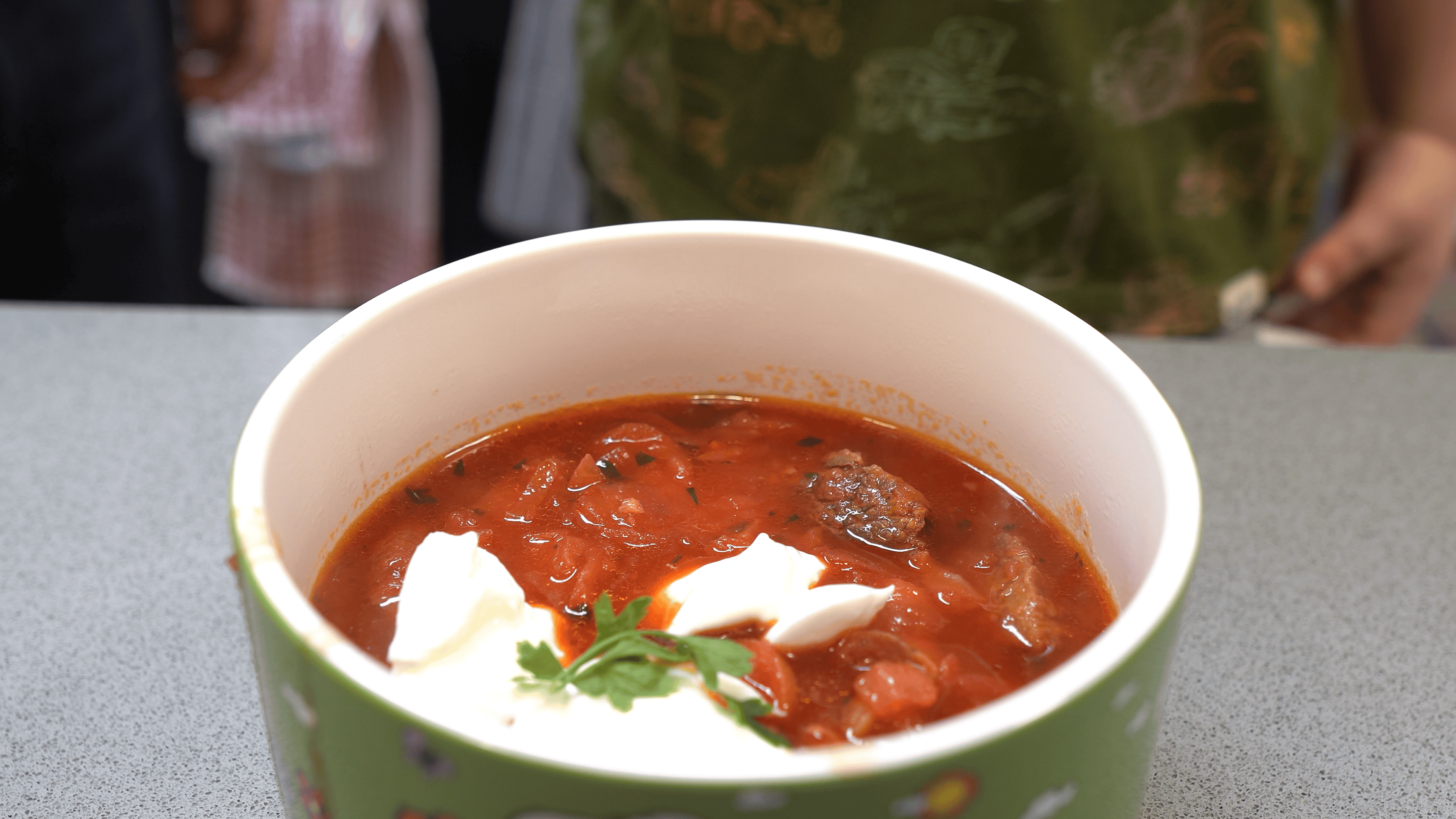Ukrainian Borscht: From America With Love

Ukrainian Borscht is one of my all-time favorite soups. As someone who has lived in New York City for over a decade, I have fond memories of eating borscht at all hours of the day (and night) at Veselka in the East Village. That’s where my knowledge of Ukrainian culture truly started.
Borscht is probably my favorite soup outside of Asia (for me, it’s hard to top Tom Yum, Hot and Sour, Udon, Ramen, etc.). Not only is borscht delicious, it has a rich history. One thing I love about cooking is how it can transport you to another culture and place. So before we dive into the recipe (which you can jump to below), let’s explore the history of Ukrainian borscht.
Ukrainian Borscht and its Ukrainian Roots
I may not be Ukrainian, but I have a deep respect for their cultural identity and history, even as an imperialist power tries to compromise its sovereignty. When preparing this recipe, I studied the Ukrainian origins of this dish and gained inspiration from multiple recipes I found online. One of the best was from iFoodReal (check it out!).
In general, borscht is a beloved Eastern European soup that is made in a variety of cultures, including Russia, but its origins are distinctly Ukrainian. Its history is so uniquely Ukrainian that UNESCO added borscht to its List of Intangible Cultural Heritage in Need of Urgent Safeguarding.
The origins of borscht can be traced back to modern-day Ukraine where it began as a soup derived from hogweed, which is a plant locally known as borschevik (this is where the name “borscht” comes from). When beets were introduced to Eastern Europe, they became the signature ingredient in the soup, giving it the distinctive red color it has today.
There is no one recipe for Ukrainian Borscht
As the Ukrainian woman noted in this video, everyone has their own spin on Ukrainian Borscht (each of her sisters has a different recipe!). For example, I think it’s unnecessary to add vinegar and sugar or maple syrup for a sweet and sour effect. I also prefer to make my borscht with beef stock, where I boil some form of bone-in beef (in the recipe below I used beef shank) to further enhance the savory flavor of the soup.
The point is that there appears to be no “one right way” to make Ukrainian Borscht, unlike some dishes where there are hard and fast rules that nobody should break. With that said, there are a few staples that must be included:
- Beets – you probably can’t call it borscht unless you include this staple vegetable
- Carrots, onions, and potatoes – I saw these vegetables in nearly every recipe I reviewed, although I’m sure some substitutions are possible
- Meat – pork and beef are often included, although vegetarian borscht is perfectly acceptable and in fact encouraged by many Ukrainians
- Garnishes and aromatics like garlic
- Umami – tomato paste is often the primary source for an intense umami kick, but I’ve also seen ingredients like fermented beet juice
Ukrainian Borscht is a cultural symbol
Just as Banitsa is distinctly representative of Bulgaria and Bulgarian food, borscht is the same for Ukraine. It’s a symbol of family, community, and national identity. Borscht is often shared with friends and neighbors. Recipes are passed down through generations, with each family having its own take and flair.
So it’s important to note here that I’m not Ukrainian, and I don’t have the luxury of this generational knowledge when it comes to making borscht. But when I was crafting and executing my recipe I was trying to respect the cultural traditions and do justice to the dish. You be the judge on whether I succeeded.

Ukrainian Borscht
Ingredients
- 12 cups beef stock I boil bone-in beef shank to create a broth ahead of cooking the remainder of the ingredients.
- 1 medium-sized cabbage, sliced green or red (not sliced too big or small)
- 1 tbsp olive oil for sauteeing onion, carrots, and beets
- 1 large yellow onion chopped
- 4 medium-sized carrots chopped
- 8 small beets or 3-4 large beets
- 4 large potatoes I use russet
- 1 can tomato paste for umami!
- salt to taste
- pepper to taste
- 1 bulb garlic reduce to a few cloves if a bulb is too much for you
- 1/4 cup parsley dill is ideal, but I only had parsley when I made this recipe
- 1 cup greek yogurt for serving – alternatively, you could use sour cream, but yogurt is better
- 1 loaf rye bread for serving
Instructions
- In a large pot or dutch oven (I used a 5.5 quart one), add bone-in beef shank, 12 cups of water, and bring to a boil. Simmer beef for at least 1 hour before proceeding.
- Wash and chop cabbage, and add to the broth
- Simultaneously preheat a skillet with olive oil and add chopped onions and carrots – saute for 5-10 minutes until caramelized
- Add beets to the skillet and saute for a few more minutes
- Add tomato paste to the skillet and stir to incorporate fully – saute for a few minutes before transferring to the broth/cabbage
- Add potatoes to the broth mixture, in addition to salt and pepper, cover and bring to a boil, reducing to a simmer for 20-30 minutes (at least)
- Once vegetables have softened and incorporated fully into the broth, turn off the heat and add garlic and parsley (leaving some parsley for final garnishing)
- Stir and let the borscht sit for 20-30 minutes so all of the flavors marry each other
- Serve with a tablespoon of yogurt and parsley garnish, in addition to a few slices of rye bread – enjoy!



0 Comments